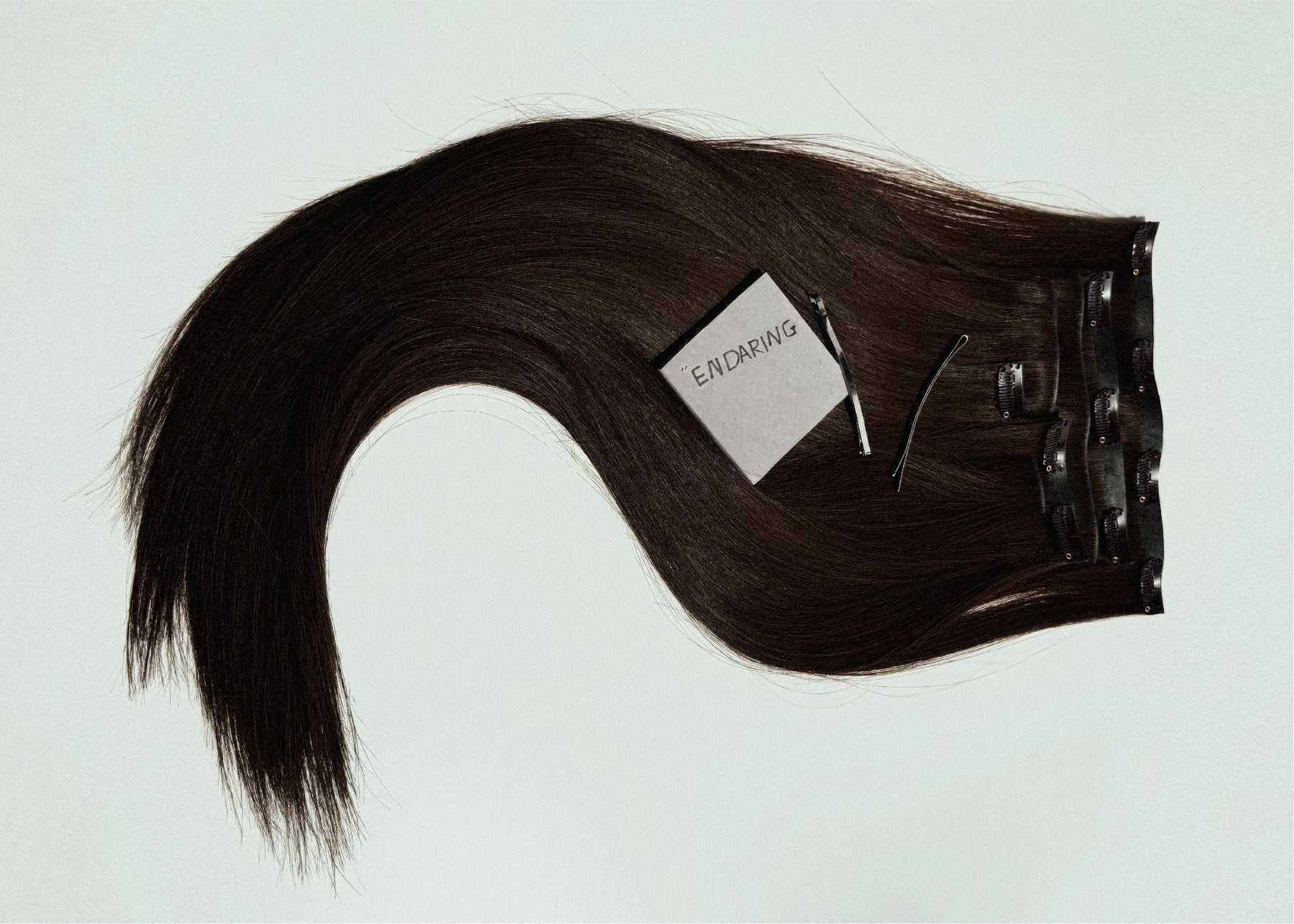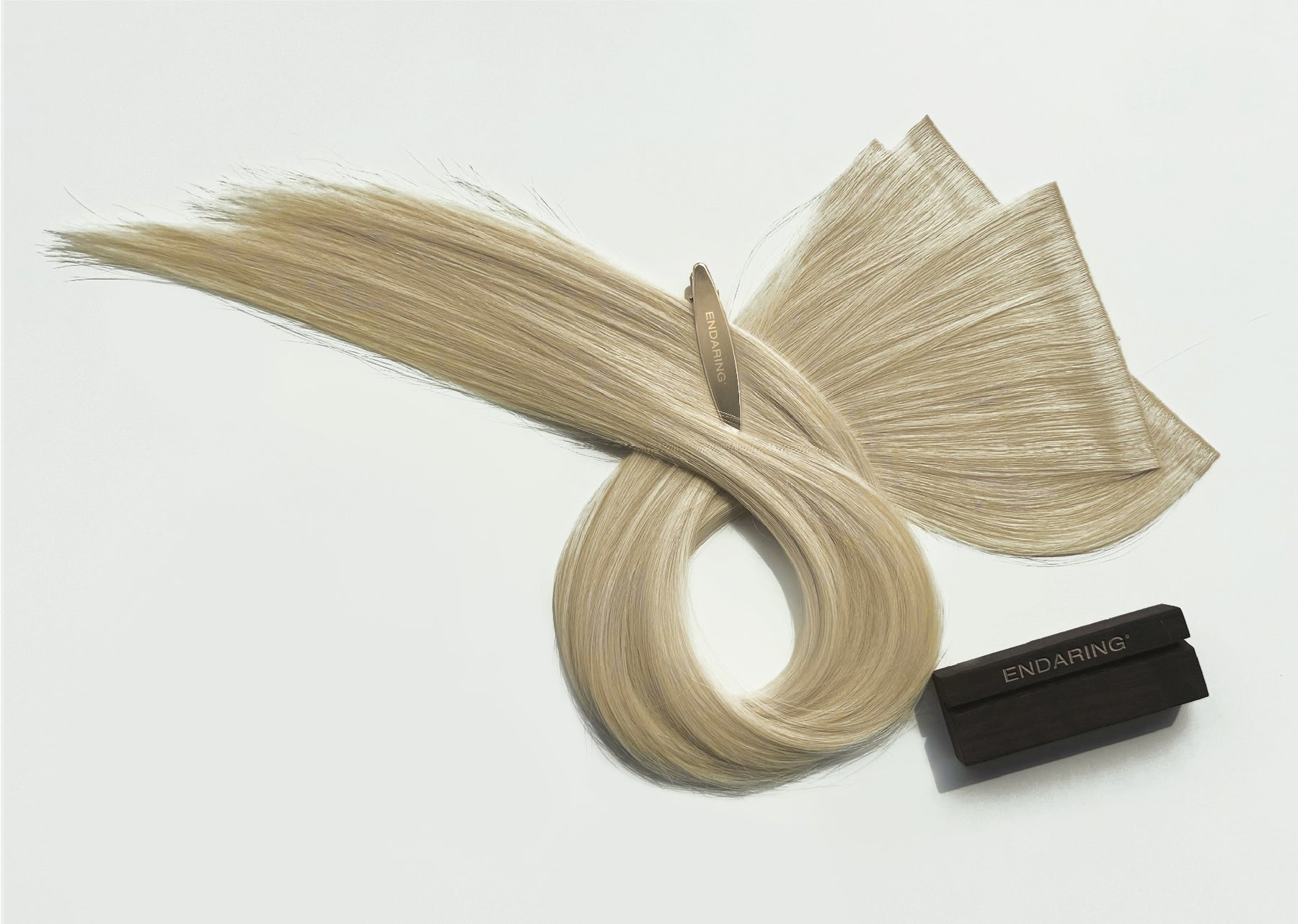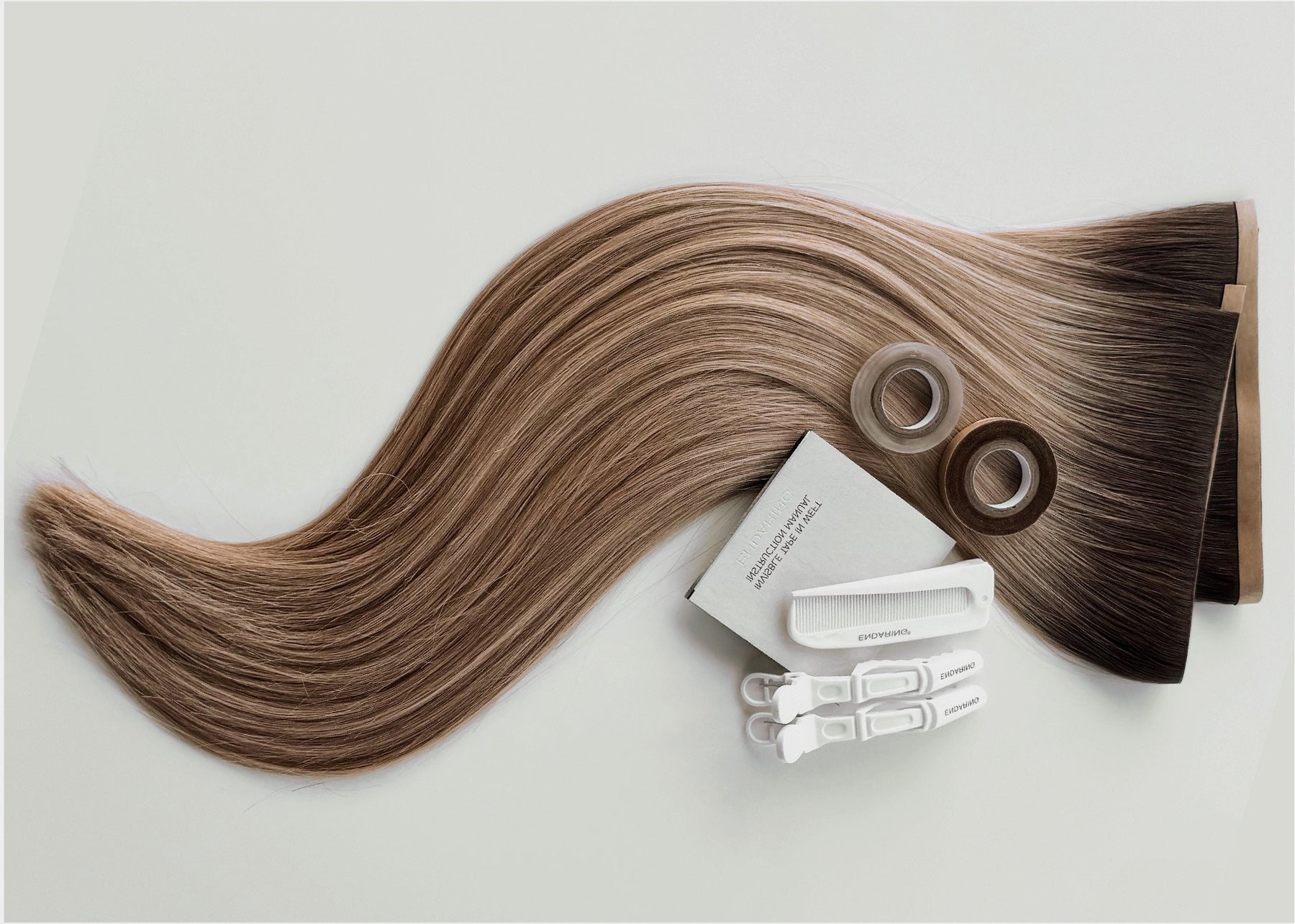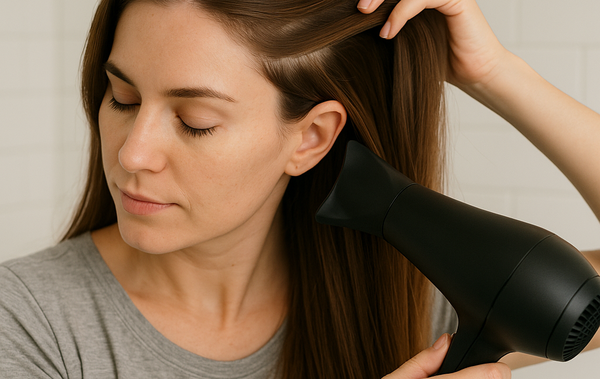If you’ve ever worn tape-in weft extensions, you know how much of a game-changer they can be—fuller hair, instant length, and all the styling freedom in the world. But here’s the part no one gets excited about: taking them out. Most of us picture sticky glue, tugging at our roots, and maybe even a few snapped strands. I’ve been there, and trust me, it doesn’t have to be that stressful.
In this post, I’m breaking down exactly how to take tape in weft extensions out at home—without the panic, without the damage, and without needing to run back to the salon. I’ll share the tools and products I rely on, the step-by-step routine I follow, the mistakes I learned the hard way, and the aftercare that keeps my natural hair happy. Think of it as me sitting on the bathroom floor with you, guiding you through every step, so your extensions slide out smoothly and your real hair stays healthy.
1) Preparing Your Hair Before Removal
When someone asks how to take tape in weft extensions out at home, I start with prep because prep saves hair. I brush through my hair from ends to roots to remove knots before I touch the adhesive. I divide my hair into clean, horizontal sections with a rat-tail comb and clip the rest out of the way. I keep a small mirror nearby so I can check the back of my head, and I set my remover, clips, cotton pads, and a fine-mist bottle of water within reach. I turn on bright lighting, so I don’t guess where the tapes sit—I see them. Good prep turns a “pull and pray” situation into a calm, controlled process.
I also prime my hair for remover. If my scalp or hair feels very slick with oil, I lightly blot the roots with a dry towel, so the remover doesn’t run everywhere. If my hair feels desert-dry, I avoid static by smoothing a drop of light oil on the mid-lengths only (not on the tape) so detached wefts don’t snag when I slide them out. I tell myself: slow is fast. Five minutes of prep can save me from breakage that takes months to grow out.
I set expectations before I begin. Old installs, hard water buildup, or tapes applied too close to the scalp can take longer. I test one sandwich first. If that first removal needs more time or more product, I adjust before I move across my whole head. I never plan this right before an event; I give myself an unhurried window, so I don’t rush and tug.
2) Best Products to Help Remove Tape-In Wefts at Home
When I explain how to take tape in weft extensions out at home, I sort removers into 2 buckets: alcohol-based options, and oils. I still patch-test on my skin near the ear, because citrus and fragrances can bother sensitive scalps.
Alcohol-based sprays (typically isopropyl around 70%) slice through many medical-grade adhesives quickly. I spray just enough to wet the tape seam, then wait 30–60 seconds. I avoid soaking my scalp to keep it from drying out. Alcohol performs best when I reapply in small bursts rather than one drench; repeated light applications dissolve adhesive layers without stripping my hair’s length.
Oil-based removers feel gentle and budget-friendly. They work by softening the adhesive over time and giving the tape a slick surface to release from. I apply a few drops right at the seam, wait a couple of minutes, and add more only if needed. Oil-based removers usually take longer and can leave a bit of residue, so I always plan a clarifying wash afterward. If my scalp is naturally oily or my hair is very fine, I prefer alcohol spray instead, just to avoid heavy roots that linger for days.
I keep support tools handy: duckbill clips for tidy sectioning, cotton swabs to place remover precisely, and a wide-tooth comb to detangle freed wefts. I skip harsh solvents like acetone near my scalp. I also leave essential oils out of this job; undiluted essential oils can irritate skin and don’t outperform a proper remover.
3) Step-by-Step Guide on How to Take Tape In Weft Extensions Out at Home
When I talk through how to take tape in weft extensions out at home, I follow the same repeatable sequence every time, so I protect my natural hair:
-
Section small and secure. I expose one tape sandwich at a time. I clip away surrounding hair, so I don’t coat healthy strands in remover.
-
Apply remover precisely. I aim the spray or dropper right on the seam where the two tape strips meet, not all over my roots. Targeted product works better and keeps my scalp happier.
-
Wait—then test. I give the remover 30–60 seconds to penetrate. I gently pinch the top tape with my fingers and feel for slip. If it doesn’t budge, I add a little more remover and wait again.
-
Create a tiny opening. I wiggle the tabs horizontally to open a narrow gap. I never yank down. Horizontal movement breaks the adhesive seal without stressing my hair.
-
Peel back with control. I lift the top tape away from the hair, then I slide the bottom tape downward with my thumb while supporting my roots with my other hand. I keep both motions small and patient.
-
Reapply as needed. If I feel resistance, I stop, re-mist the seam, and let the remover do more work. Force equals breakage, so I choose product over power.
-
Remove residue while I go. I use a cotton pad or my thumb to roll off any gummy bits from the freed section. Rolling beats scraping.
-
Comb through the shed hair. I expect some natural shed trapped in the tape; that’s normal. I gently comb it out from ends to roots before I move to the next sandwich.
-
Repeat in rows. I move across one row, then I drop the next section. A clean, consistent pattern keeps me organized and prevents re-tangling.
-
Spot-clean sticky roots. If a patch stays tacky, I dab a tiny bit of remover directly on it, massage for a few seconds, and wipe clean.
-
Collect the wefts. I lay freed wefts flat, sticky side up on foil or plastic so they don’t pick up lint. If I plan to re-use them, I’ll fully de-tack and retape later.
-
Finish with a scalp check. I touch along my partings to make sure no tabs hide under layers. A quick check now saves me from finding a stray tape in the shower.
I keep the same rules for every head: no metal edge scraping on the scalp, no pulling from the ends of the weft, and no “it’ll loosen in the shower” shortcuts. If a sandwich refuses to open, I walk away from it for two minutes, let the remover keep working, and come back with fresh hands.
4) Common Mistakes People Make When Removing Tape-In Wefts
I see the same pitfalls whenever folks try how to take tape in weft extensions out at home without a plan. The biggest mistake? Tugging. Pulling turns one sticky seam into dozens of snapped baby hairs. I never pull to “test strength.” Instead, I reapply remover and increase wait time.
Skipping sectioning causes chaos. When loose hair falls into the remover zone, it becomes gummy and harder to detangle. Clean partings keep adhesive and healthy hair separate. Over-soaking creates a new problem; drowning the area with remover can drip into the eyes or dry out the scalp. I use small, repeated applications.
Using heat to “melt” tape sounds clever, but I never put a flat iron on adhesive next to my scalp. Heat can smear glue into pores and turn cleanup into a nightmare. Rushing the last row also bites people. Fatigue sets in, and that’s when hair snaps. I schedule breaks and hydrate like I would during a long color session.
Wrong product choice trips up many first-timers. Strong acetone strips skin; heavy essential oil blends irritate scalps. A proper bond remover or isopropyl-based spray works cleaner and kinder. Skipping the residue check leaves sticky roots that attract lint and dust. I always do a fingertip sweep along my partings before I declare victory.
5) Aftercare Once You’ve Removed Your Tape-In Extensions
After I finish how to take tape in weft extensions out at home, I treat aftercare like the second half of the job. I start with a clarifying shampoo at the roots to lift remover and adhesive residue. If I used lots of oil, I emulsify a small amount of shampoo in my hands and massage it onto dry or barely damp roots first; that trick grabs oil better. I rinse thoroughly, then I shampoo again only if my roots still feel slick.
I follow with targeted conditioning. If my hair feels rubbery or stretched from the removal, I choose a bond-building or protein-light mask and leave it on for the full time. If my hair feels brittle or squeaky after clarifying, I reach for a moisturizing mask or deep conditioner. I avoid heavy conditioners right at the roots on day one, so I don’t weigh the scalp down after all that remover work.
I also reset the scalp. A gentle scalp serum or soothing tonic calms any redness from parting and clipping. I let my hair air-dry or blow-dry on low heat, then I micro-trim any frayed ends that show up once the weight of the extensions disappears. A tiny dusting keeps the ends from splitting the strand.
If I plan to re-install, I give my scalp a rest—usually 48–72 hours—so natural oils rebalance and any micro-tension fades. I store freed wefts flat and clean. If I want to reuse them, I remove old tape completely (rubbing alcohol or a dedicated tape remover helps), wash the entire weft thoroughly—not just the band area—let it dry completely, and then apply fresh tape.




